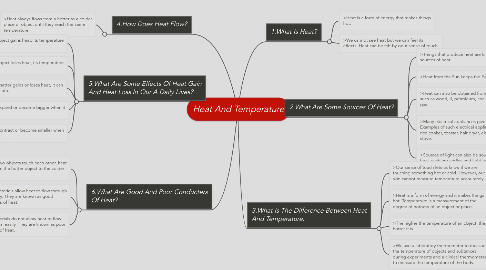Heat And Temperature
作者:Naufal s049

1. 4.How Does Heat Flow?
1.1. >Heat always flows from a hotter to a colder place or object until they reach the same temperature.
2. 5.What Are Some Effects Of Heat Gain And Heat Loss In Our A Daily Lives?
2.1. >When an object gains heat, its temperature increases.
2.2. >When an object loses heat, its temperature decreases.
2.3. >When matter gains or loses heat, it can change state.
2.4. >Matter can expand or become bigger when it gains heat.
2.5. >Matter can contract or become smaller when it loses heat.
3. 6.What Are Good And Poor Conducters Of Heat?
3.1. >When two objects touch each other, heat flows from the hotter object to the colder object.
3.2. >Some materials allow heat to flow through them easily. They are known as good conductors of heat.
3.3. >Other materials do not allow heat to flow through them easily. They are known as poor conductors of heat.
4. 1.What Is Heat?
4.1. >Heat is a form of energy that makes things hot.
4.2. >We cannot see heat but we can feel its effects. Heat can be felt by oour sense of touch.
5. 2.What Are Some Sources Of Heat?
5.1. >Things that produce heat are known as sources of heat.
5.2. >Heat from the Sun keeps the Earth warm.
5.3. >Heat can also be obtained from burning fuels such as wood, il, petroleum, coal and natural gas.
5.4. >Many electrical appliances give off heat too. Examples of such electrical appliances are oven, rice cooker, toaster, hair dryer, electric iron and stove.
5.5. >Sources of light can also be souces of heat, such as candles and light bulbs.
6. 3.What Is The Difference Between Heat And Temperature.
6.1. >Our sense of touch lets us know if we are touching something hot or cold. However, our skin cannot measure temperature accourately.
6.2. >Heat is a form of energy and it makes things hot. Temperature is a measurement of the degree of hotness of an object or place.
6.3. >The higher the temperature of an object, the hotter it is.
6.4. >We use a laboratory thermometer to measure the temperature of objects and subtances during experiments and a clinical thermometer to measure the temperature of the body.


